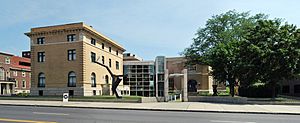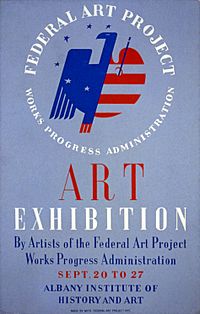- This page was last modified on 17 October 2025, at 10:18. Suggest an edit.
Albany Institute of History & Art facts for kids

South elevation and east profile of Rice Building; south profile of entrance building and main building, 2011
|
|
| Established | 1791 |
|---|---|
| Location | 125 Washington Avenue, Albany, New York |
The Albany Institute of History & Art (AIHA) is a museum in Albany, New York. It collects and shares the history, art, and culture of Albany and the Upper Hudson Valley region. You can find it on Washington Avenue in downtown Albany. Started in 1791, it is one of the oldest museums in the United States.
Over the years, several groups joined together to form today's Albany Institute. It began as a group focused on science and even advised the state government on farming. Famous people like Robert R. Livingston were involved. Later, it focused more on art and history. It got its current name in 1926. Today, it is a well-known regional art museum.
The museum has three main buildings. One is the Rice Building, built in the late 1800s. It's a beautiful Beaux-Arts style mansion. The main building was built in the 1920s in a Classical Revival style. A modern glass building connects these two older structures. The original two buildings were added to the National Register of Historic Places in 1976. In the early 2000s, the museum was updated. A new entrance building was added, and special storage for the collections was built.
Contents
Exploring the Museum Buildings
The Albany Institute is located on a large piece of land between Washington and Elk Street. It is surrounded by other old and important buildings. Across Dove Street is the University Club of Albany, which has a similar style. Nearby are the New York State Department of Education Building and the New York State Capitol.
The Rice Building is on the corner of Washington and Dove Street. It has a small lawn with trees and a modern sculpture. A low fence separates the museum from the street. The main entrance has tall stone pillars and a modern steel and glass roof. The larger main building is on the other side of the property. A modern glass and stone walkway connects the two buildings.
The main building is a two-story brick structure. It has decorative stone corners and a stone band around the middle. The roof is sloped and green, with a flat tower in the center. On the south side, the main entrance is in a round section that sticks out. Inside, a large hallway leads from the entrance to a big hall. Staircases go up to the second floor. Some doorways have Doric columns.
The Rice Building has golden brick walls and a flat roof. It has a slightly smaller wing that extends from the north side. On the east side, there is a porch with a railing, which is now the main entrance. The windows on the first floor are large and round, with decorative iron railings. The second floor has double windows. The roof has a fancy decorative edge with carvings.
Inside the Rice Building, many original features are still there. These include rooms with decorative wall art, carved mahogany fireplaces, and built-in bookshelves in the library. A staircase with an iron railing leads to the third floor. The marble in the bathroom is also original.
A Look at the Museum's History
The Albany Institute started as a group that advised the state on farming. It has grown into a major regional art museum. It faced challenges twice in the 1800s but was saved by changing its focus. In the late 1900s, it finally found its permanent purpose and home.
Early Years: Promoting Useful Arts (1791–1823)
The Society for the Promotion of Agriculture, Arts and Manufactures was the first group that led to today's museum. It started in New York City in 1791. This group advised the state government on how to improve farming and the economy. Many of its 72 founders were also state lawmakers. Robert R. Livingston, who signed the Declaration of Independence, was its first president. Other important early members included John Jay and George Clinton.
When Albany became the state capital in 1796, the Society moved there. In 1804, it changed its name to the Society for the Promotion of the Useful Arts. In 1814, it created a Fine Arts Committee. This committee asked artist Ezra Ames to paint a portrait of Robert Livingston, who had passed away. This painting was the museum's first art piece. In 1819, the state created its own agriculture agency, so it no longer needed to fund the Society. The group became less active.
The Albany Institute Forms (1823–1850)
The museum was brought back to life in 1823 when it joined with the Albany Lyceum of Natural History. The Lyceum focused on natural sciences like geology and mineralogy. It collected rocks and plant samples from state surveys.
The new combined group was called the Albany Institute. It had over a hundred members. In 1829, Joseph Henry, who worked in the Institute's natural history department, shared his first paper on electromagnetism. He later became very famous for his work in this area. In 1830, the Institute's library grew when Governor DeWitt Clinton left most of his books to it.
Joseph Henry left in 1832 to teach at Princeton. He later became the first leader of the Smithsonian Institution. Even without him, the Albany Institute had over a thousand members the next year. However, attendance at meetings later dropped because one member, Matthew Henry Webster, presented too many papers on weather surveys. Financial problems also hurt the Institute during the Panic of 1837. Despite this, it continued to collect scientific samples, which helped start the New York State Museum.
The death of Stephen Van Rensselaer in 1839 was another challenge. Also, new colleges like Union College and Rensselaer Polytechnic Institute began doing similar work. The Institute became quiet throughout the 1840s.
Focusing on History and Art (1851–1899)
The Institute was revived again in 1851. John V. L. Pruyn, a Congressman, became president in 1857. He changed the group's focus to be more for the public. In 1867, the Institute gave its science collections to the state, which became part of the state museum.
In 1886, Albany celebrated its 200th birthday. An exhibit of historical items and art was held. After this, the Albany Historical and Art Society (AHAS) was formed to care for these collections. It had almost 1,200 members. By 1897, AHAS bought a building on State Street and added to it. The next year, it took over the collection of the Albany Gallery of Fine Art, which had closed years earlier.
Becoming the Albany Institute of History & Art (1900–1947)
In 1900, AHAS and the Albany Institute merged. The new name was the Albany Institute and Historical and Art Society. In 1904, it bought the land where the main building stands today. The new building was finished in 1908. The mayor called it "the capstone of educational development in our city." Its first exhibit in 1909 celebrated Henry Hudson's exploration of the Hudson River and Robert Fulton's first steamboat trip.
To make more space for exhibits, the institute gave some of its books to the new Harmanus Bleecker Library in 1924. Two years later, it shortened its name to the "Albany Institute of History & Art." This was part of an effort to make the collections more open to the public. During the Great Depression, the museum offered tours, school trips, and performances. This helped it become known as a regional museum. It also started the Print Club of Albany, bringing famous printmakers to the city. In 1936, it hosted an exhibit of local art.

Poster for 1938 exhibition of contemporary regional artists sponsored by Federal Art Project
In the 1940s, John Davis Hatch became the director. He started showing works by important regional artists. One exhibit on Thomas Cole was the first major show of his work in the 1900s. In 1945, an exhibit called "The Negro Artist Comes of Age" showed the work of 45 African American artists. It gained national attention. Hatch also worked to update the museum's records.
A Regional Art Museum Today (1948–Present)
Robert Wheeler took over as director in 1948. He decided that new art pieces should be from the region or have a connection to it. He created special exhibits of regional art and updated the galleries.
In 1956, Janet McFarlane became director. She was one of only seven women museum directors in the U.S. at that time. In 1961, the museum's Women's Council was founded. This group now helps raise money and provides volunteers. In 1968, the Rice family donated their old house to the museum. This house was renovated and used for offices and galleries. As director, Norman Rice helped the museum acquire over a million items before he retired in 1986.
Christine Miles became director next. In 1989, the museum held its first Museum Ball and Art Auction. This event raised money for a new fund to buy contemporary art. The museum also began a project to better organize its collections. This made them easier for researchers and the public to access. In 1990, the "City Neighbors" project created an exhibit about the black experience in Albany.
The museum needed new facilities. In 1994, an architect was hired for the job. The museum's leaders decided to raise $12.5 million for the project. Sculptor George Rickey donated one of his works, Etoile Variation V, to be placed in the entrance. The money was raised through grants. The museum closed in 1999 for renovations and reopened in 2001.
Museum Collections
The Albany Institute has over 20,000 items in its permanent collections. This includes 1,600 paintings, 1,100 drawings, 4,000 prints, and 600 sculptures. It also has 500 pieces of furniture, 1,200 ceramics, and 4,000 pieces of clothing. The library has 140,000 books and 85,000 photographs. Besides its permanent exhibits, the museum also hosts many traveling exhibits each year.
Gallery
What You Can See: Permanent Exhibits
The museum's main exhibits are on two floors of its original building.
- The Landscape That Defined America: The Hudson River School: This exhibit features paintings by famous artists like Frederic Church, Thomas Cole, and Asher B. Durand. These artists were part of the Hudson River School movement.
- Sense of Place: 18th and 19th Century Paintings and Sculpture: This exhibit includes important portraits by Ezra Ames and Ralph Earl. It also has everyday life paintings by Walter Launt Palmer.
- 19th Century American Sculpture: This gallery shows 20 sculptures by artists like Erastus Dow Palmer.
- Ancient Egypt: This exhibit features the museum's two mummies and other ancient Egyptian items.
- Traders and Culture: Colonial Albany and the Formation of American Identity: This exhibit explores the city of Albany in the 1600s and 1700s.
- Entry Point Gallery: This is the first gallery visitors see. It displays a selection of the museum's newest art and historical items.
Visiting the Museum
The Albany Institute of History & Art is open Wednesday to Saturday from 10:00 a.m. to 5:00 p.m. On Sundays, it is open from 12:00 p.m. to 5:00 p.m.
Admission costs $10.00 for adults. It's $8.00 for senior citizens and students. For children aged six to twelve, it costs $6.00. Kids under five get in for free. The museum's library is open on Thursdays from 1:00 p.m. to 4:30 p.m. You can also visit by making an appointment. The museum has a parking lot behind the building.
See also
- List of museums in New York
- National Register of Historic Places listings in Albany, New York
- George Rogers Howell, secretary





